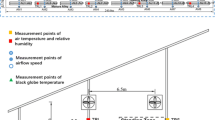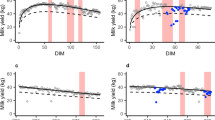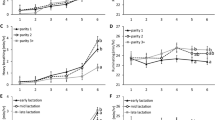Abstract
This study aimed to better understand environmental heat stress and physiological heat strain indicators in lactating dairy cows. Sixteen heat stress indicators were derived using microenvironmental parameters that were measured at the surrounding of cows and at usual fixed locations in the barn by using handheld and fixed subarea sensors, respectively. Twenty high-producing Holstein–Friesian dairy cows (> 30.0 kg/day) from an intensive dairy farm were chosen to measure respiration rate (RR), vaginal temperature (VT), and body surface temperature of forehead (FT), eye (ET), and muzzle (MT). Our results show that microenvironments measured by the handheld sensor were slightly warmer and drier than those measured by the fixed subarea sensor; however, their derived heat stress indicators correlated equally well with physiological indicators. Interestingly, ambient temperature (Ta) had the highest correlations with physiological indicators and the best classification performance in recognizing actual heat strain state. Using segmented mixed models, the determined Ta thresholds for maximum FT, mean FT, RR, maximum ET, mean ET, VT, mean MT, and maximum MT were 24.1 °C, 24.2 °C, 24.4 °C, 24.6 °C, 24.6 °C, 25.3 °C, 25.4 °C, and 25.4 °C, respectively. Thus, we concluded that the fixed subarea sensor is a reliable tool for measuring cows’ microenvironments; Ta is an appropriate heat stress indicator; FT, RR, and ET are good early heat strain indicators. The results of this study could be helpful for dairy practitioners in a similar intensive setting to detect and respond to heat strain with more appropriate indicators.







Similar content being viewed by others
References
Altman DG, Bland JM (1983) Measurement in medicine: the analysis of method comparison studies. J R Stat Soc Ser D (Stat) 32:307–317. https://doi.org/10.2307/2987937
Amamou H, Beckers Y, Mahouachi M, Hammami H (2019) Thermotolerance indicators related to production and physiological responses to heat stress of holstein cows. J Therm Biol 82:90–98. https://doi.org/10.1016/j.jtherbio.2019.03.016
Baeta FC, Meador NF, Shanklin MD, Johnson HD (1987) Equivalent temperature index at temperatures above the thermoneutral for lactating dairy cows. American Society of Agricultural Engineers, St. Joseph, p 874015
Becker CA, Collier RJ, Stone AE (2020) Invited review: physiological and behavioral effects of heat stress in dairy cows. J Dairy Sci 103:6751–6770. https://doi.org/10.3168/jds.2019-17929
Bertocchi L, Vitali A, Lacetera N, Nardone A, Varisco G, Bernabucci U (2014) Seasonal variations in the composition of Holstein cow’s milk and temperature–humidity index relationship. Animal 8:667–674. https://doi.org/10.1017/S1751731114000032
Bianca W (1962) Relative importance of dry- and wet-bulb temperatures in causing heat stress in cattle. Nature 195:251–252. https://doi.org/10.1038/195251a0
Blanco-Penedo I, Velarde A, Kipling RP, Ruete A (2020) Modeling heat stress under organic dairy farming conditions in warm temperate climates within the Mediterranean basin. Clim Change 162:1269–1285. https://doi.org/10.1007/s10584-020-02818-y
Bohmanova J, Misztal I, Cole JB (2007) Temperature-humidity indices as indicators of milk production losses due to heat stress. J Dairy Sci 90:1947–1956. https://doi.org/10.3168/jds.2006-513
Buffington DE, Collazo-Arocho A, Canton GH, Pitt D, Thatcher WW, Collier RJ (1981) Black globe-humidity index (BGHI) as comfort equation for dairy cows. Trans ASAE 24:711–0714. https://doi.org/10.13031/2013.34325
Burfeind O, Von Keyserlingk MAG, Weary DM, Veira DM, Heuwieser W (2010) Short communication: repeatability of measures of rectal temperature in dairy cows. J Dairy Sci 93:624–627. https://doi.org/10.3168/jds.2009-2689
Carabaño MJ, Logar B, Bormann J, Minet J, Vanrobays ML, Díaz C, Tychon B, Gengler N, Hammami H (2016) Modeling heat stress under different environmental conditions. J Dairy Sci 99:3798–3814. https://doi.org/10.3168/jds.2015-10212
Chen C-S, Chen W-C (2019) Research and development of automatic monitoring system for livestock farms. Appl Sci 9:1132. https://doi.org/10.3390/app9061132
Collier RJ, Dahl GE, VanBaale MJ (2006) Major advances associated with environmental effects on dairy cattle. J Dairy Sci 89:1244–1253. https://doi.org/10.3168/jds.s0022-0302(06)72193-2
Collier RJ, Laun WH, Rungruang S, Zimbleman RB (2012) quantifying heat stress and its impact on metabolism and performance. In: Florida Ruminant Nutrition Symposium, Gainesville, FL, USA, 31 January–1 February 2012 2012. University of Florida, Gainesville, FL, USA, pp 74–83
Dalcin VC, Fischer V, Daltro DdS, Alfonzo EPM, Stumpf MT, Kolling GJ, Silva MVGBd, McManus C (2016) Physiological parameters for thermal stress in dairy cattle. Rev Bras Zootec 45:458–465. https://doi.org/10.1590/S1806-92902016000800006
Davison C, Michie C, Hamilton A, Tachtatzis C, Andonovic I, Gilroy M (2020) Detecting heat stress in dairy cattle using neck-mounted activity collars. Agriculture 10:210. https://doi.org/10.3390/agriculture10060210
Dikmen S, Hansen PJ (2009) Is the temperature-humidity index the best indicator of heat stress in lactating dairy cows in a subtropical environment? J Dairy Sci 92:109–116. https://doi.org/10.3168/jds.2008-1370
Gaughan JB, Holt SM, Hahn GL, Mader TL, Eigenberg R (2000) Respiration rate—is it a good measure of heat stress in cattle? Asian-Aust J Anim Sci 13:329–332
Gaughan JB, Mader TL, Holt SM, Lisle A (2008) A new heat load index for feedlot cattle. J Anim Sci 86:226–234. https://doi.org/10.2527/jas.2007-0305
Gorczyca MT, Gebremedhin KG (2020) Ranking of environmental heat stressors for dairy cows using machine learning algorithms. Comput Electron Agric 168:105124. https://doi.org/10.1016/j.compag.2019.105124
Hammami H, Bormann J, M’Hamdi N, Montaldo HH, Gengler N (2013) Evaluation of heat stress effects on production traits and somatic cell score of Holsteins in a temperate environment. J Dairy Sci 96:1844–1855. https://doi.org/10.3168/jds.2012-5947
Hempel S, König M, Menz C, Janke D, Amon B, Banhazi TM, Estellés F, Amon T (2018) Uncertainty in the measurement of indoor temperature and humidity in naturally ventilated dairy buildings as influenced by measurement technique and data variability. Biosys Eng 166:58–75. https://doi.org/10.1016/j.biosystemseng.2017.11.004
Herbut P (2013) Temperature, humidity and air movement variations inside a free-stall barn during heavy frost. Ann Anim Sci 13:587–596. https://doi.org/10.2478/aoas-2013-0025
Hoffmann G, Herbut P, Pinto S, Heinicke J, Kuhla B, Amon T (2020) Animal-related, non-invasive indicators for determining heat stress in dairy cows. Biosys Eng 199:83–96. https://doi.org/10.1016/j.biosystemseng.2019.10.017
Ji B, Banhazi T, Ghahramani A, Bowtell L, Wang C, Li B (2020) Modelling of heat stress in a robotic dairy farm. Part 1: thermal comfort indices as the indicators of production loss. Biosys Eng 199:27–42. https://doi.org/10.1016/j.biosystemseng.2019.11.004
Kabuga JD (1992) The influence of thermal conditions on rectal temperature, respiration rate and pulse rate of lactating Holstein-Friesian cows in the humid tropics. Int J Biometeorol 36:146–150. https://doi.org/10.1007/BF01224817
Kadzere CT, Murphy MR, Silanikove N, Maltz E (2002) Heat stress in lactating dairy cows: a review. Livest Prod Sci 77:59–91. https://doi.org/10.1016/S0301-6226(01)00330-X
Kovács L, Kezer FL, Ruff F, Jurkovich V, Szenci O (2018) Assessment of heat stress in 7-week old dairy calves with non-invasive physiological parameters in different thermal environments. PLoS ONE 13:e0200622. https://doi.org/10.1371/journal.pone.0200622
Lees JC, Lees AM, Gaughan JB (2018) Developing a heat load index for lactating dairy cows. Anim Prod Sci 58:1387. https://doi.org/10.1071/AN17776
Li S, Gebremedhin KG, Lee C, Collier R (2009) Evaluation of thermal stress indices for cattle. ASABE Annual International Meeting, Reno, p 096003
Li G, Chen S, Chen J, Peng D, Gu X (2020) Predicting rectal temperature and respiration rate responses in lactating dairy cows exposed to heat stress. J Dairy Sci 103:5466–5484. https://doi.org/10.3168/jds.2019-16411
Mader T, Davis M, Brown-Brandl T (2006) Environmental factors influencing heat stress in feedlot cattle. J Anim Sci 84:712–719. https://doi.org/10.2527/2006.843712x
Mader TL, Johnson LJ, Gaughan JB (2010) A comprehensive index for assessing environmental stress in animals. J Anim Sci 88:2153–2165. https://doi.org/10.2527/jas.2009-2586
Maia ASC, daSilva RG, Battiston Loureiro CM (2005) Sensible and latent heat loss from the body surface of Holstein cows in a tropical environment. Int J Biometeorol 50:17–22. https://doi.org/10.1007/s00484-005-0267-1
Mbuthia JM, Mayer M, Reinsch N (2021) Modeling heat stress effects on dairy cattle milk production in a tropical environment using test-day records and random regression models. Animal 15:100222–100222. https://doi.org/10.1016/j.animal.2021.100222
Mondaca MR, Choi CY, Cook NB (2019) Understanding microenvironments within tunnel-ventilated dairy cow freestall facilities: examination using computational fluid dynamics and experimental validation. Biosys Eng 183:70–84. https://doi.org/10.1016/j.biosystemseng.2019.04.014
NRC (1971) A guide to environmental research on animals. National Academy Press, Washington, D.C.
Peng D, Chen S, Li G, Chen J, Wang J, Gu X (2019) Infrared thermography measured body surface temperature and its relationship with rectal temperature in dairy cows under different temperature-humidity indexes. Int J Biometeorol 63:327–336. https://doi.org/10.1007/s00484-018-01666-x
Pinto S, Hoffmann G, Ammon C, Amon T (2020) Critical THI thresholds based on the physiological parameters of lactating dairy cows. J Therm Biol 88. https://doi.org/10.1016/j.jtherbio.2020.102523
Qiao Y, Kong H, Clark C, Lomax S, Su D, Eiffert S, Sukkarieh S (2021) Intelligent perception for cattle monitoring: a review for cattle identification, body condition score evaluation, and weight estimation. Comput Electron Agric 185:106143. https://doi.org/10.1016/j.compag.2021.106143
Ranjitkar S, Bu D, Van Wijk M, Ma Y, Ma L, Zhao L, Shi J, Liu C, Xu J (2020) Will heat stress take its toll on milk production in China? Clim Change 161:637–652. https://doi.org/10.1007/s10584-020-02688-4
Sartori R, Sartor-Bergfelt R, Mertens SA, Guenther JN, Parrish JJ, Wiltbank MC (2002) Fertilization and early embryonic development in heifers and lactating cows in summer and lactating and dry cows in winter. J Dairy Sci 85:2803–2812. https://doi.org/10.3168/jds.S0022-0302(02)74367-1
Schüller LK, Heuwieser W (2016) Measurement of heat stress conditions at cow level and comparison to climate conditions at stationary locations inside a dairy barn. J Dairy Res 83:305–311. https://doi.org/10.1017/S0022029916000388
Shu H, Wang W, Guo L, Bindelle J (2021) Recent advances on early detection of heat strain in dairy cows using animal-based indicators: a review. Animals 11:980. https://doi.org/10.3390/ani11040980
Tian H, Liu J, Chen X, Li S, Li X, Mengal K, Lu Y, Wang D (2021) Effects of ambient temperature and humidity on body temperature and activity of heifers, and a novel idea of heat stress monitoring. Anim Prod Sci 61:1584–1591. https://doi.org/10.1071/AN20156
Wang X, Gao H, Gebremedhin KG, Bjerg BS, Van Os J, Tucker CB, Zhang G (2018) A predictive model of equivalent temperature index for dairy cattle (ETIC). J Therm Biol 76:165–170. https://doi.org/10.1016/j.jtherbio.2018.07.013
Wijffels G, Sullivan M, Gaughan J (2021) Methods to quantify heat stress in ruminants: current status and future prospects. Methods 186:3–13. https://doi.org/10.1016/j.ymeth.2020.09.004
Wildman EE, Jones GM, Wagner PE, Boman RL, Troutt HF, Lesch TN (1982) A dairy cow body condition scoring system and its relationship to selected production characteristics. J Dairy Sci 65:495–501. https://doi.org/10.3168/jds.S0022-0302(82)82223-6
Yan G, Li H, Zhao W, Shi Z (2020) Evaluation of thermal indices based on their relationships with some physiological responses of housed lactating cows under heat stress. Int J Biometeorol 64:2077–2091. https://doi.org/10.1007/s00484-020-01999-6
Yan G, Liu K, Hao Z, Shi Z, Li H (2021) The effects of cow-related factors on rectal temperature, respiration rate, and temperature-humidity index thresholds for lactating cows exposed to heat stress. J Therm Biol 100:103041. https://doi.org/10.1016/j.jtherbio.2021.103041
Yousef MK (1985) Stress physiology: definition and terminology. CRC Press, Boca Raton
Acknowledgements
The authors are grateful for the assistance received from Yinxiang dairy farm in Shandong, China.
Funding
This work was supported by Major Science and Technology Program of Inner Mongolia Autonomous Region, grant number 2020ZD0004; Key Research and Development Plan of Hebei Province, grant number 20327202D; and Key Research and Development Plan of Hebei Province, grant number 20326602D.
Author information
Authors and Affiliations
Corresponding author
Ethics declarations
Ethics approval
The experimental protocols were approved by the Experimental Animal Care and Committee of Institute of Animal Sciences, Chinese Academy of Agricultural Sciences (approval number IAS2021-220).
Conflict of interest
The authors declare no competing interests.
Rights and permissions
About this article
Cite this article
Shu, H., Guo, L., Bindelle, J. et al. Evaluation of environmental and physiological indicators in lactating dairy cows exposed to heat stress. Int J Biometeorol 66, 1219–1232 (2022). https://doi.org/10.1007/s00484-022-02270-w
Received:
Revised:
Accepted:
Published:
Issue Date:
DOI: https://doi.org/10.1007/s00484-022-02270-w




